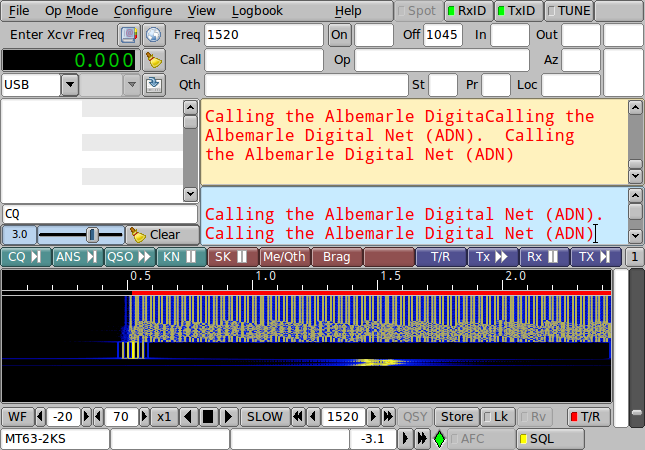
As of last monday, there is a digital net on the 146.730 repeater on monday nights at 8:15PM local time, shortly after the info net (which is voice and on a separate frequency). Probably using MT63-2000 modulation which works well over FM and at least passably with accoustic coupling between computer and radio (no interface needed), although a interface such as a signalink USB would be better. A number of software packages support this, including fldigi (Linux, Free-BSD, OS X, Windows XP, NT, W2K, Vista and Win7). There are also MT63 apps for android and iphone. Include the supplemental programs which are sometimes packaged separately from fldigi as some of these are used to support Narrow Band Emergency Messaging System (. NBEMS) transmission of emergency message forms.
I did not get the email so I don’t know all the details – just what I have overheard; please post any corrections in the comment section.
You don’t need special equipment above what most hams already have. Just a 2m radio, a laptop/desktop/netbook computer, tablet, or smart phone, and a computer microphone/speakers (if adequate ones are not built in).
Those without a ham license may still be able to view the content by using an ordinary analog radio scanner tuned to 146.760 and fldigi or similar software. A funcube dongle or RTL-SDR may also work instead of a scanner or radio for reception.
EDIT: Olivia 8/50 will also be used. Here is what Mike McPherson KQ9P wrote about the first one.
Please join us for the new Albemarle Amateur Radio Club Digital Net (ADN). To get started, the ADN will meet on Mondays at 8:15pm local after the AARC Monday Night Info Net, starting next Monday, 20 May 2013. The purpose of the ADN is to encourage experimentation with digital modes and operating techniques, and to provide opportunities for interested participants to gain experience as Network Control Stations (NCS) in a digital environment. All licensed amateur radio operators are invited to participate, including visitors to the area. The ADN will not, at least at first, handle routine traffic, but we will be prepared to handle emergency should there be any.
Although I am kicking this off and will serve as the initial NCS, I don’t intend for this to be a one-man show. If you are interested in participating as an NCS please email me. We will rotate NCS primary and backup duties so everyone gets experience.
Let’s start off by keeping it simple this first time. Dave K4DND has kindly offered the use of the 146.730MHz repeater. I will call the net and take check-ins via voice. Following check-ins, we will conduct this first session using the Olivia 8/500 and MT63-2000L modes at 1000Hz on the waterfall. (The reason for choosing these two modes is that they work well via “acoustic coupling,” literally holding your HT up to the speaker/mic on your computer and keying the PTT manually. Dave and I have tested this, and it works very well.) I will transmit some text messages for everyone to receive, then provide opportunities for all those who so desire to transmit text messages themselves. I’ll intersperse voice announcements and instructions, so it won’t be all-digital.
If you are an old hand at digital modes you are welcome to use the software and hardware with which you are already familiar. If this is all new to you, I recommend that you consider the fldigi software package. It is open source and free; versions are available for Windows, Mac, and Linux; and it is quite feature-rich. Dave Kleber KB3FXI, the organizer of the paNBEMS, has done some really nice instructional videos. Take a look at http://youtu.be/SWZ2vKWSilE and http://youtu.be/-1wZ7uIA-Qs. (Keep in mind that the current version of fldigi is newer, so some things will have moved around and look different. Also, we won’t be using flmsg at first.)
Mike (KQ9P) has set up a mailing list. To be added, email him at his email address which you will find in the club roster.
Since more than one protocol is being used, make sure you have RSID (Reed Solomon ID) turned on for these protocols.
This will signal to the receiver which is being used. These probably default to on for these protocols in FLDIGI (but not for some narrow band protocols due to the wide bandwidth of RSID). Also, RSID detection should be turned on. Configure -> IDS.
